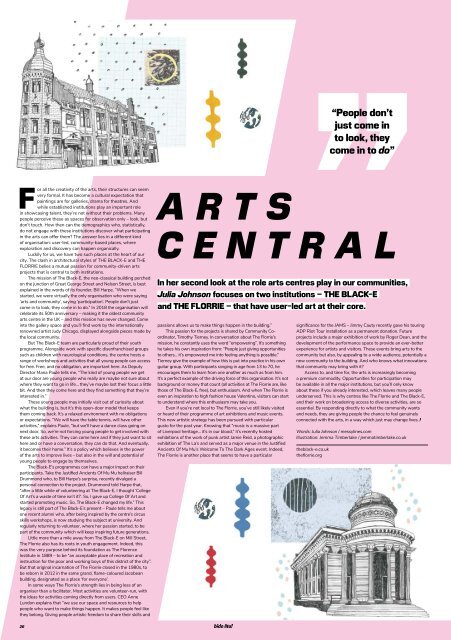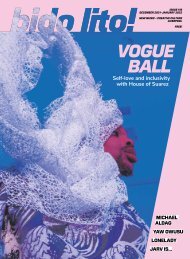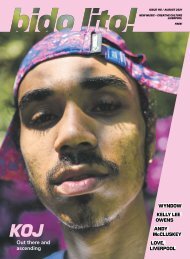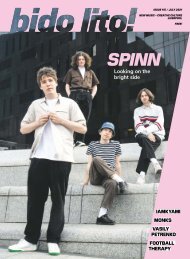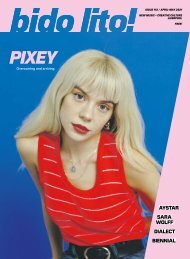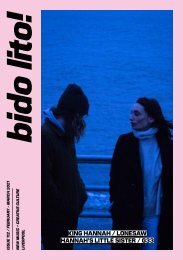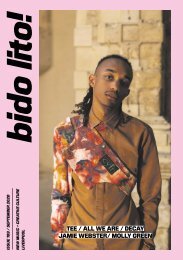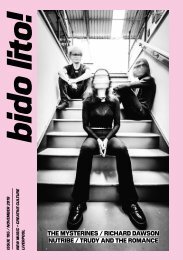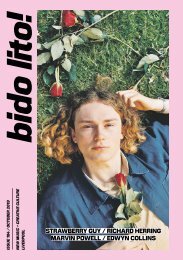Issue 84 / Dec 2017/Jan 2018
December 2017/January 2018 issue of Bido Lito! Featuring LO FIVE, TAYÁ, NICK POWER, MAC DEMARCO, LIVERPOOL MUSIC WEEK 2017 REVIEW and much more. Plus a special look at our need for space and independent venues, coinciding with a report into the health of Liverpool's music infrastructure.
December 2017/January 2018 issue of Bido Lito! Featuring LO FIVE, TAYÁ, NICK POWER, MAC DEMARCO, LIVERPOOL MUSIC WEEK 2017 REVIEW and much more. Plus a special look at our need for space and independent venues, coinciding with a report into the health of Liverpool's music infrastructure.
Create successful ePaper yourself
Turn your PDF publications into a flip-book with our unique Google optimized e-Paper software.
ROYAL LIVERPOOL PHILHARMONIC ORCHESTRA<br />
& THE BOOTLEG BEATLES<br />
For all the creativity of the arts, their structures can seem<br />
very formal. It has become a cultural expectation that<br />
paintings are for galleries, drama for theatres. And<br />
while established institutions play an important role<br />
in showcasing talent, they’re not without their problems. Many<br />
people perceive these as spaces for observation only – look, but<br />
don’t touch. How then can the demographics who, statistically,<br />
do not engage with these institutions discover what participating<br />
in the arts can offer them? The answer lies in a different kind<br />
of organisation: user-led, community-based places, where<br />
exploration and discovery can happen organically.<br />
Luckily for us, we have two such places at the heart of our<br />
city. The clash in architectural styles of THE BLACK-E and THE<br />
FLORRIE belies a mutual passion for community-driven arts<br />
projects that is central to both institutions.<br />
The mission of The Black-E, the neo-classical building perched<br />
on the junction of Great George Street and Nelson Street, is best<br />
explained in the words of its founder, Bill Harpe. “When we<br />
started, we were virtually the only organisation who were saying<br />
‘arts and community’, saying ‘participation’. People don’t just<br />
come in to look, they come in to do.” In <strong>2018</strong> the organisation will<br />
celebrate its 50th anniversary – making it the oldest community<br />
arts centre in the UK – and this mission has never changed. Come<br />
into the gallery space and you’ll find work by the internationally<br />
renowned artist Judy Chicago, displayed alongside pieces made by<br />
the local community.<br />
But The Black-E team are particularly proud of their youth<br />
programme. Alongside work with specific disenfranchised groups<br />
such as children with neurological conditions, the centre hosts a<br />
range of workshops and activities that all young people can access<br />
for free. Free, and no obligation, are important here. As Deputy<br />
Director Maria Paule tells me, “The kind of young people we get<br />
at our door are young people who really are maybe not sure about<br />
where they want to go in life... they’ve maybe lost their focus a little<br />
bit. And then they come here and they find something that they’re<br />
interested in.”<br />
These young people may initially visit out of curiosity about<br />
what the building is, but it’s this open-door model that keeps<br />
them coming back. It’s a relaxed environment with no obligations<br />
or expectations. “We will have the table tennis, will have other<br />
activities,” explains Paule, “but we’ll have a dance class going on<br />
next door. So, we’re not forcing young people to get involved with<br />
these arts activities. They can come here and if they just want to sit<br />
here and or have a conversation, they can do that. And eventually,<br />
it becomes their home.” It’s a policy which believes in the power<br />
of the arts to improve lives – but also in the will and potential of<br />
young people to engage by themselves.<br />
The Black-E’s programmes can have a major impact on their<br />
participants. Take the Justified Ancients Of Mu Mu hellraiser Bill<br />
Drummond who, to Bill Harpe’s surprise, recently divulged a<br />
personal connection to the project. Drummond told Harpe that,<br />
“after a little while of volunteering at The Black-E, I thought ‘College<br />
Of Art’s a waste of time isn’t it?’. So, I gave up College Of Art and<br />
started promoting music. So, The Black-E changed my life.” This<br />
legacy is still part of The Black-E’s present – Paule tells me about<br />
one recent alumni who, after being inspired by the centre’s circus<br />
skills workshops, is now studying the subject at university. And<br />
regularly returning to volunteer, where her passion started, to be<br />
part of the community which will keep inspiring future generations.<br />
Little more than a mile away from The Black-E on Mill Street,<br />
The Florrie also has its roots in youth engagement. Indeed, this<br />
was the very purpose behind its foundation as The Florence<br />
Institute in 1889 – to be “an acceptable place of recreation and<br />
instruction for the poor and working boys of this district of the city”.<br />
But that original incarnation of The Florrie closed in the 1980s, to<br />
be reborn in 2012 in the same grand, flame-coloured Jacobean<br />
building, designated as a place ‘for everyone’.<br />
In some ways The Florrie’s strength lies in being less of an<br />
organiser than a facilitator. Most activities are volunteer-run, with<br />
the ideas for activities coming directly from users. CEO Anne<br />
Lundon explains that “we use our space and resources to help<br />
people who want to make things happen. It makes people feel like<br />
they belong. Giving people artistic freedom to share their skills and<br />
“People don’t<br />
just come in<br />
to look, they<br />
come in to do”<br />
ON SALE 9AM FRIDAY 22 SEPTEMBER<br />
ARTS<br />
CENTRAL<br />
ECHOARENA.COM | 0<strong>84</strong>4 8000 400<br />
Calls cost 5p per minute plus your phone company’s access charge<br />
In her second look at the role arts centres play in our communities,<br />
Julia Johnson focuses on two institutions – THE BLACK-E<br />
and THE FLORRIE – that have user-led art at their core.<br />
passions allows us to make things happen in the building.”<br />
This passion for the projects is shared by Community Coordinator,<br />
Timothy Tierney. In conversation about The Florrie’s<br />
mission, he constantly uses the word “empowering”. It’s something<br />
he takes his own inspiration from: “People just giving opportunities<br />
to others... it’s empowered me into feeling anything is possible.”<br />
Tierney give the example of how this is put into practice in his own<br />
guitar group. With participants ranging in age from 13 to 70, he<br />
encourages them to learn from one another as much as from him.<br />
It’s a perfect example of the driving force of this organisation. It’s not<br />
background or money that count (all activities at The Florrie are, like<br />
those of The Black-E, free), but enthusiasm. And when The Florrie is<br />
even an inspiration to high fashion house Valentino, visitors can start<br />
to understand where this enthusiasm may take you.<br />
Even if you’re not local to The Florrie, you’ve still likely visited<br />
or heard of their programme of art exhibitions and music events.<br />
This new artistic strategy has been pursued with particular<br />
gusto for the past year. Knowing that “music is a massive part<br />
of Liverpool heritage… it’s in our blood,” it’s recently hosted<br />
exhibitions of the work of punk artist Jamie Reid, a photographic<br />
exhibition of The La’s and served as a major venue in the Justified<br />
Ancients Of Mu Mu’s Welcome To The Dark Ages event. Indeed,<br />
The Florrie is another place that seems to have a particular<br />
significance for the JAMS – Jimmy Cauty recently gave his touring<br />
ADP Riot Tour installation as a permanent donation. Future<br />
projects include a major exhibition of work by Roger Dean, and the<br />
development of the performance space to provide an ever-better<br />
experience for artists and visitors. These events bring arts to the<br />
community but also, by appealing to a wide audience, potentially a<br />
new community to the building. And who knows what innovations<br />
that community may bring with it?<br />
Access to, and time for, the arts is increasingly becoming<br />
a premium commodity. Opportunities for participation may<br />
be available in all the major institutions, but you’ll only know<br />
about these if you already interested, which leaves many people<br />
underserved. This is why centres like The Florrie and The Black-E,<br />
and their work on broadening access to diverse activities, are so<br />
essential. By responding directly to what the community wants<br />
and needs, they are giving people the chance to feel genuinely<br />
connected with the arts, in a way which just may change lives. !<br />
Words: Julia Johnson / messylines.com<br />
Illustration: Jemma Timberlake / jemmatimberlake.co.uk<br />
theblack-e.co.uk<br />
theflorrie.org<br />
26


